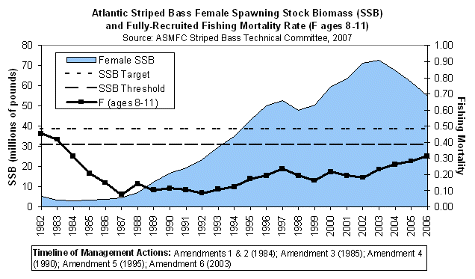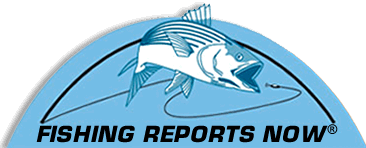ASFMC: Striped Bass Stock Is Healthy
From the Atlantic States Marine Fisheries Commission:
FOR IMMEDIATE RELEASE, FEBRUARY 5, 2008
Striped Bass Stock Assessment Indicates Healthy Stock
Female Spawning Stock Biomass Remains High
Female Spawning Stock Biomass Remains High
Scientific advice presented to the Commission's Atlantic Striped Bass Management Board indicates that striped bass management under Amendment 6 to the Interstate Plan continues to be a success. The benchmark stock assessment, recently endorsed by an independent panel of fishery scientists, concluded that striped bass are not overfished and overfishing is not occurring. The assessment estimates that the resource remains at a high level with spawning stock biomass (SSB) at 55 million pounds, well above the SSB target and threshold levels of 38.6 and 30.9 million pounds, respectively. Estimates of juvenile abundance showed several years of strong recruitment, with the 2003 cohort being the strongest in the time series. The statistical catch at age (SCA) model used by the Striped Bass Technical Committee estimated the 2006 fishing mortality rate on age 8-11 fish to be F=0.31, which is below the Amendment 6 fishing mortality threshold of 0.41. Retrospective analysis of the SCA model, as well as tag-based estimates of fishing mortality presented in the assessment, indicate that the 2006 fishing mortality is also below the Amendment 6 target of 0.30.

The Peer Review Panel endorsed the use of the SCA model for producing SSB and fishing mortality estimates that can be judged against the current biological reference points. The new model is a significant departure from the virtual population analysis that has been used to assess striped bass stock status since 1997. It is an aged-based model that projects the population numbers-at-age forward through time, rather than backwards, given model estimates of recruitment and age-specific total mortality. Additional tag-based results from the catch-equation method support the SCA model’s results that striped bass are not overfished.
Based on advice of the Technical Committee, the Board maintained the states' management programs at status quo. The Technical Committee will continue to monitor the status of the stock and refine stock assessment methodology as necessary. The next stock assessment update will be conducted in 2009.
Copies of the stock assessment will be available on the Commission website (www.asmfc.org under Breaking News) by mid-February. For more information, please contact Nichola Meserve, Fisheries Management Plan Coordinator, at (202)289-6400 or <nmeserve@asmfc.org>.
###
ASMFC Vision: Healthy, self-sustaining populations of all Atlantic coast fish species or successful restoration well in progress by the year 2015.





